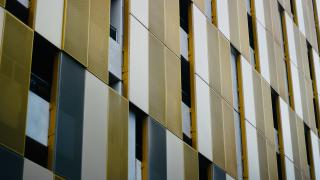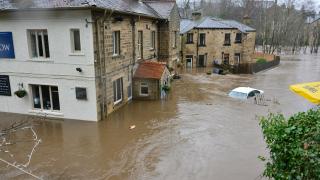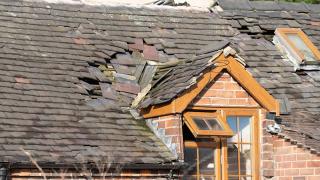This is the first in a series of articles developed by Woodgate & Clark's Nick Turner, looking at the challenges and opportunities associated with achieving zero carbon in building.
The UK built environment is responsible for approximately 25% of total UK greenhouse gas emissions and the UK has a legally binding target to reach net zero by 2050. At COP26 the Government committed to achieving 68% reductions in carbon emissions by 2030. The insurance industry has a role to play in helping to achieve these targets through the choice of materials used in building repairs, and this first article examines the challenges of measuring carbon emissions. We will then go on to look at specific materials and their carbon emissions.
Measuring Carbon Emissions
Measuring carbon emissions and the plans to reduce carbon emissions are large and very complex issues at the top of the world’s agenda for change. In buildings, to date, government policy has focused entirely on operational emissions. That is how to make buildings more energy efficient. The embodied carbon cost of the construction is not required by current policy to be assessed or controlled, other than on a voluntary basis.
As a result, there has been little progress in reducing these emissions within the built environment. This means low-carbon building products cannot meet current demand and compounding this problem, there are insufficient incentives to develop and use these materials.
For example, obstacles remain in timber products that prevent their take up in construction. These include:
• Issues regarding fire risk and insurance
• Price volatility
• Securing sustainable and local supply chains
• Addressing skills gaps in the use of timber.
To address this challenge, there could be a requirement to undertake whole-life carbon assessments for buildings that is set within building regulations and the planning system. This would provide a measure for progressive carbon targets for buildings, to match the pathway to net zero.
This approach could incentivise:
• More retrofitting
• The development and use of low-carbon materials
• Investment in low-carbon construction skills.
Materials
Total carbon emissions of all building materials and products and the construction involved to put them together is known as a building’s embodied carbon. Embodied carbon accounts for about 20% of the carbon emissions from the building sector.
Construction materials and the construction process itself are referred to as ‘low-carbon’ rather than zero carbon. Low-carbon building materials are materials with both low embodied energy and carbon in their production, assembly, and transportation processes.
A huge number of materials and products used in building, such as concrete, steel and aluminium, are created by a production process of raw material extraction, raw material process, melting, manufacture to final products, and transportation to building sites. Each of the steps consumes energy, which is also expressed in terms of carbon emissions. Reducing embodied carbon is one of the most practical mitigation options for the building industry. This can be done by using carbon sink and low carbon materials and products in buildings.
Carbon sink building materials are mainly sourced from harvested wood products (HWPs). Wood is harvested from trees that capture carbon through the process of photosynthesis. Fifty per cent of the dry weight of wood is carbon, and the amount of carbon in 1m3 of wood is similar to that in about 350 litres of petrol.
Not all building materials can be carbon-sinks and so low-carbon building materials should be used as much as possible.
This sounds easy, but due to the broad-based definition, low-carbon building materials are interpreted differently in different contexts. For example, metal products are considered to be high-embodied carbon materials because the extraction and refinement processes involved are carbon intensive. However, recycled metal products used in new buildings can be considered low-carbon.
So, what are the choices?
The building material with the lowest carbon footprint is widely considered to be Rammed Earth.
It is basically an old technique that uses only natural raw materials such as earth, chalk, lime or gravel and it is considered as the most sustainable building method.
An example of this is cob, a mixture of clay earth and straw that is mixed with water and used to form walls in layers. It has been used in Devon for centuries and is making a return due to its environmental credentials. It has around 48kg of embodied carbon per m3.
The next most environmentally friendly material is softwood timber. The definition of softwood is wood from gymnosperm trees (e.g. pines, spruce, etc.).
There is a return to timber framed housing by a number of developers and softwood is often used to frame modular building sections due to its light weight and sustainability. Softwood has an average of 110kg of embodied carbon per m3.
However, timber related industries in the UK are responsible for 0.35% of UK emissions (around 1.5M tonnes of CO2) and is also responsible for around 3.6M tonnes of CO2e of imported embodies emissions from processing and transporting timber from overseas.
Key UK industry timber trade associations have launched the Timber Industry Net Zero Roadmap to tackle this. 49% of emissions are related to transport and so efficiencies in the use of transport and the vehicles used have significant impact, as will specifying ‘locally sourced’ timber.
34% of emissions relates to imported embodies production. This includes sawmills and panel mills which use a lot of energy to dry out the timber. Generally, natural gas is used as the key energy source but the use of waste timber to produce energy is the best carbon efficient short-term option.
Laminated timber is next. Layers of thin timber sections are glued together to form very strong sections that can span large areas. They are useful for large commercial buildings and seen in many large supermarkets in the UK. It is making a return to UK construction as it offers huge design flexibility and is very light while being very strong. It is effective acoustically and thermally and generates virtually no waste on site. The average embodied carbon is 219kg per m3.
Then we have stone. All stone requires is quarrying and shaping. It is fully natural, is durable and has been used for thousands of years. Stone emits around 237kg per m3 of embodied carbon.
To put these into perspective, we can compare them to widely used materials. Reinforced concrete emits 635kg embodied carbon per m³, glass 3600kg per m³, steel 12090kg per m3 and aluminium 18009kg per m3.
Our next article will focus on concrete and plasterboard.
For more information, please contact Nick Turner





